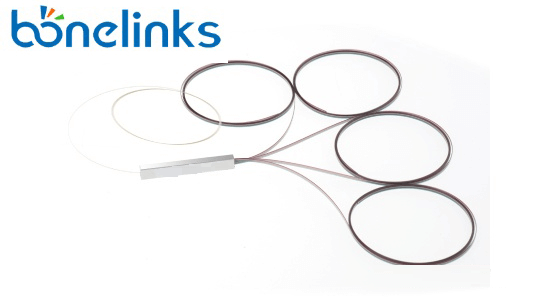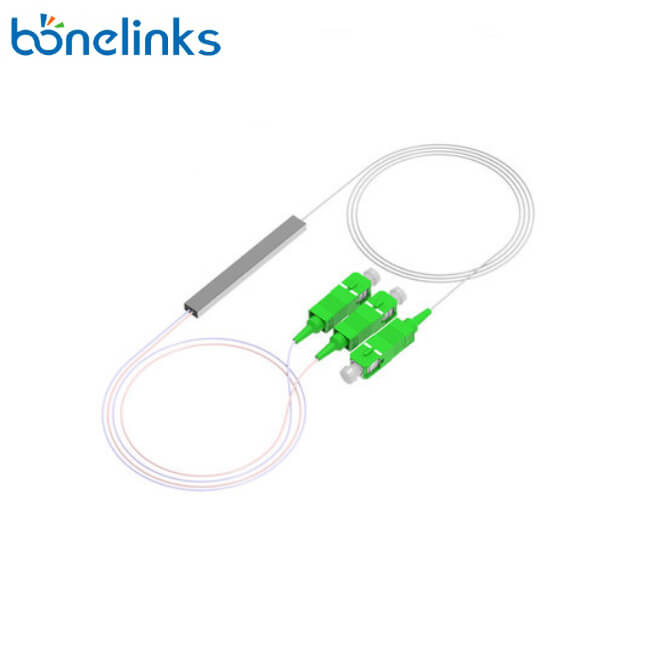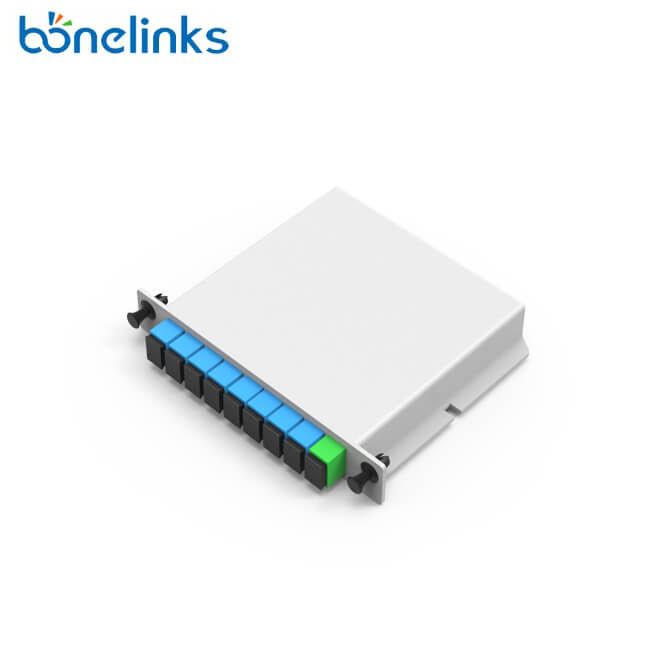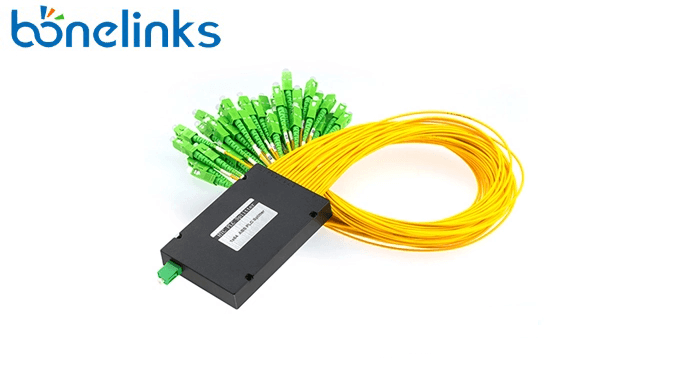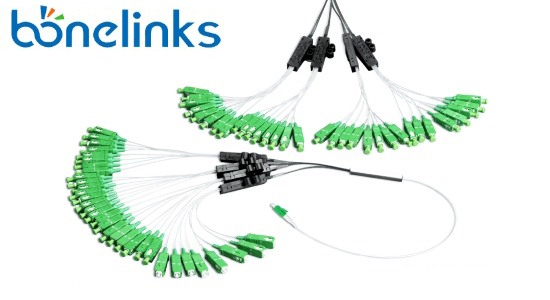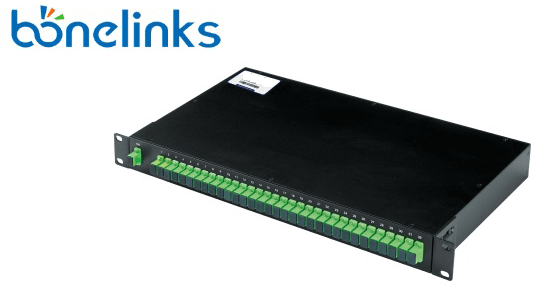FTTH (fiber to the home) access network based on PON (passive optical network) is a point-to-multipoint network structure. That is, the optical splitter is used to transmit the signal from the central office to multiple end users.
With the progress of the optical network transformation, the amount of optical splitter is increasing, and the quality of the optical splitter has an increasing impact on the optical network. Faced with many types of fiber optic splitters, many people may confused and don’t know how to choose. Let’s learn what types of fiber optic splitters are available first.
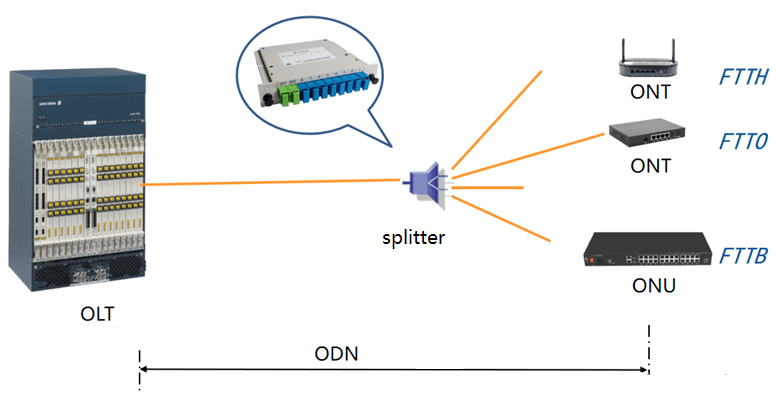
1. Fiber optic splitter types by network topology
The network topology is tree or star, and uniformity can be used. The network topology is a chain or ring type, and when distributed splitting is required, a non-uniform splitter can be used. Non-uniform optic splitters generally use FBT technology.
2. Fiber optic splitter types by production process
At present, there are two types of optical splitters: PLC optical splitter and FBT optical splitter, namely planar lightwave circuit splitter and fused biconical taper splitter.
- PLC (Planar Lightwave Circuit)
PLC splitter is a micro-optical element type product, which uses photolithography technology to form optical waveguides on a dielectric or semiconductor substrate to achieve branch distribution functions.PLC optical splitter is an integrated waveguide optical power distribution device based on a quartz substrate, which is composed of an optical splitter chip coupled with an optical fiber array at both ends. The chip is the core component, with one input and N output waveguides. The optical fiber array is located on the upper surface of the chip, and the casing is sealed to form an optical splitter with one input and N output fiber.PLC splitters are widely used in FTTx and PON.
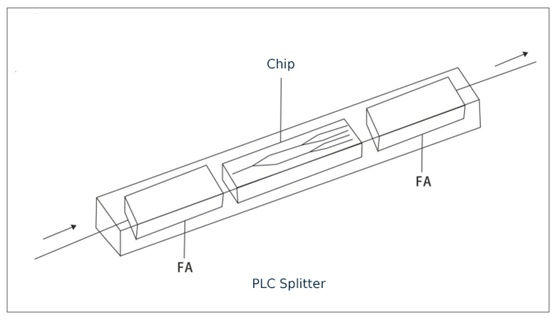
- FBT (Fused Biconical Taper)
FBT optical splitter is made by fusing two or more optical fibers on the side.The fusion taper technology is to bundle two or more optical fibers with the coating removed together, then melt and stretches them on the taper machine, and monitors the change of the splitting ratio in real-time. One fiber is reserved (the rest are cut off) as the input end, and the other end is used as the output end.
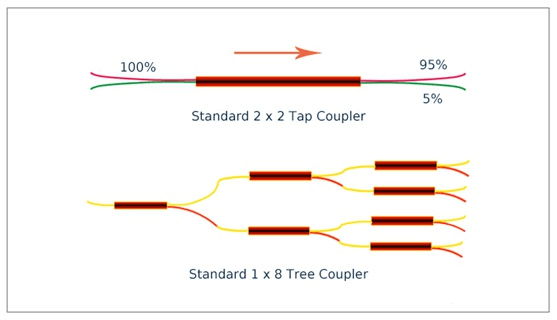
PLC optical splitter VS FBT optical splitter
The splitting principles of these two types of optical splitters are similar, and they both achieve different branch sizes by changing the mutual coupling (coupling degree, coupling length) between the fibers and changing the fiber radius.
The following table compares the differences between the two optical splitters.
| Parameters | FBT optical splitter | PLC optical splitter |
| Operating wavelengths | 850nm | 1260nm-1650nm |
| 1310nm | ||
| 1550nm | ||
| Number of inputs | One or two | One or two |
| Splitter ratio | Customizable | Equal for branches |
| Reliable splits | 1:8 (can be larger with a higher failure rate) | 1: 64 |
| Maximum splits | 1: 32 | 1: 64 |
| Others | Higher failure rate | Low failure rate |
| Lower price | Higher price |
2. Fiber optic splitter types by packaging and application
PLC splitter has excellent optical performance, high stability and high reliability, and can be widely used in the PON networks. PLC splitters have different package types to meet the application requirements of different scenarios.
- Bare fiber splitter
The bare fiber splitter is the simplest and most commonly used PLC optical splitter in FTTX projects, this type of PLC splitter has fiber left on all ends. Therefore, network engineers can splice freely according to the application. At the same time, the bare-fiber PLC splitter requires only a small amount of space during the wiring process. It is mainly suitable for occasions that are not frequently disassembled, such as cable connector boxes, optical fiber distribution boards, etc., to provide distributed signals for FTTH.
- Blockless PLC optical splitter
Blockless PLC optical splitter looks like a bare fiber splitter. The main difference from bare fiber splitters is that blockless PLC splitters use a compact stainless steel tube package, usually terminated with fiber optic connectors, and connectors usually come in SC, LC, FC and ST types. Blockless PLC optical splitter can be installed in optical cable splice box, module box and distribution box.

- Plug-in PLC splitter
Plug-in PLC splitter is widely used FTTx project, especially in the distribution of FTTx network users end. The plug-in PLC splitter is installed and fixed in the plug-in box, and the interface types are SC/FC/LC, etc. Where space requirements are low, plug-in PLC splitter provides quick installation and facilitates FTTx project deployment. The common 1X4, 1×8, 1×16, 1×32 and 2X8, 2×16, 2×32 PLC splitters are used as plug-in trays for installation in customer-specific enclosures, especially in corridors.

- ABS splitter
ABS cassette PLC optical splitter uses a plastic case. The input fiber and output fiber are on split waveguide made of a silica substrate, which provides easier and more flexible laying. In addition to providing reliable protection, the ABS package is compact and can be installed in various wiring closets or enclosures. It is very common to install an ABS cassette PLC optical splitter in a standard 19″ rack unit.

- Fan-out PLC splitter
Fan-out PLC splitter usually uses 0.9mm optical fiber. A single fiber branch is branched through a bundle of fan-out kits, which can be terminated with different types of connectors and meet the user’s requirements for different types of splitters. It can be installed in fiber splice boxes or other small terminal boxes.
- LGX cassette fiber splitter
LGX cassette fiber splitter looks like an MTP distribution box, which puts the entire PLC optical splitter in a metal box and isolates the distribution fiber embedded in the panel and the input fiber of the fiber optic adapter. It can be installed in a 19-inch 1U/2U/3U chassis, and the input and output end of the pigtail structure can be easily connected to the ODF panel adapter. LGX cassette fiber splitter features compact and miniature design, plug and play, and can be easily installed in fiber distribution boxes, fiber termination boxes and crossing connecting cabinets.
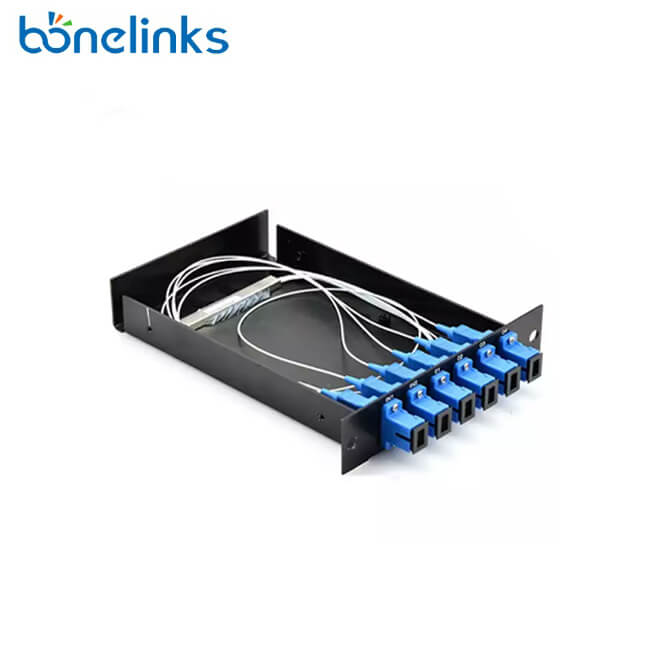
- Rack-mount splitter
Rack-mount PLC optical splitters are designed to meet the requirements of high-density data centers or server rooms. It can be firmly mounted on a data center or server rack. Multiple ports can be added to the PLC optical splitter, which is an ideal solution for high-density wiring. The rack-mounted optical splitter is designed for installation in a standard 19″ cabinet. It is generally packaged in a metal box, which is easy to install in optical fiber projects and has good protection on the PLC splitter device. There are various adapter installation interfaces such as SC, LC, FC or ST connectors. Rack-mounted optical splitters are widely used in FTTX projects, cable TV systems and data communication centers.

- Wall-mounted PLC splitter
Wall-mounted PLC splitter is usually made of ABS material, which provides reliable protection for the direct connection, termination or branch connection of the optical fiber. Double-layer structure, the upper layer is a PLC splitter, and the lower layer is a splicing disc. The wall-mounted optical splitter is used in the terminal access link in the FTTH access system to connect and protect optical devices. The wall-mounted optical splitter is suitable for corridors, basements and computer rooms, etc. It is also suitable for outdoor wall-mounted and pole-mounted installations.
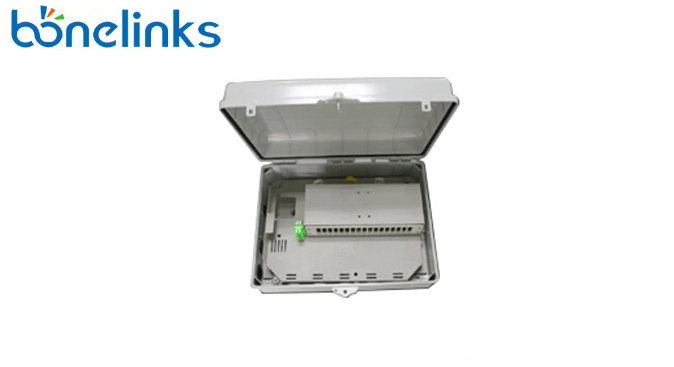
The following is a comparison of different package types of PLC splitters
| Packaging | Fiber Connector Type | Application |
| bare fiber splitter | Pigtail type without plug | cable connector boxes, optical fiber distribution boards |
| blockless PLC optical splitter
| Pigtail type without plug | optical cable splice box, module box and distribution box
|
| fan-out PLC splitter | Adapter type | fiber splice boxes or other small terminal boxes |
| ABS cassette PLC splitter | Pigtail type with plug | various wiring closets, cabinets, and enclosures. |
| rack-mount splitter
| Adapter type | 19″ cabinet |
| wall-mounted PLC splitter
| Adapter type | corridors, basements and computer rooms |
| LGX cassette fiber splitter | Adapter type | fiber distribution boxes, fiber termination boxes and crossing connecting cabinet
|
| plug-in PLC splitter | Adapter type | Optical fiber distribution frame, crossing connecting cabinet |
3. Fiber optic splitter types by transmission mode
According to the different transmission modes, optical splitters can be divided into single-mode optical splitters and multi-mode optical splitters.
In FTTX networks, long-distance low-loss single-mode fiber splitters are commonly used. In data centers, military applications, optical fiber sensing and other occasions where the channel capacity is large and the speed is fast, and the transmission distance is short (below 1000 meters), multimode fiber splitters are mostly used.
Click here to learn more about single mode and multimode.
4. Fiber optic splitter types by operating bandwidth
According to the operating bandwidth of the optical splitter, the optical splitter can be divided into single-window optical splitter and dual-window optical splitter. The window refers to the operating wavelength. The single-window optical splitter has only one working wavelength, while the dual-window optical splitter has two working wavelengths. In the dual-window optical splitter, if a multimode fiber is used, its working wavelengths are 850nm and 1310nm, and if a single-mode fiber is used, its working wavelengths are 1310nm and 1550nm.
5. Fiber optic splitter types by connector
Optic splitters can be divided into connectors with SC, LC, FC and ST, etc.
Click here to learn more about SC, LC, FC and ST connectors.
6. Fiber optic splitter types by splitting ratio
The optical splitter divides an input optical signal into a plurality of output optical signals with a certain splitting ratio. For example, an optical splitter with a split ratio of 1:4 can equally divide an optical signal into 4 parts and transmit them in 4 different channels. According to the different splitting ratios, it is divided into several splitters with splitting ratios of 1:2, 1:4, 1:8, 1:16, 1:32, and 1:64. When necessary, 2:N optical splitter can also be used.
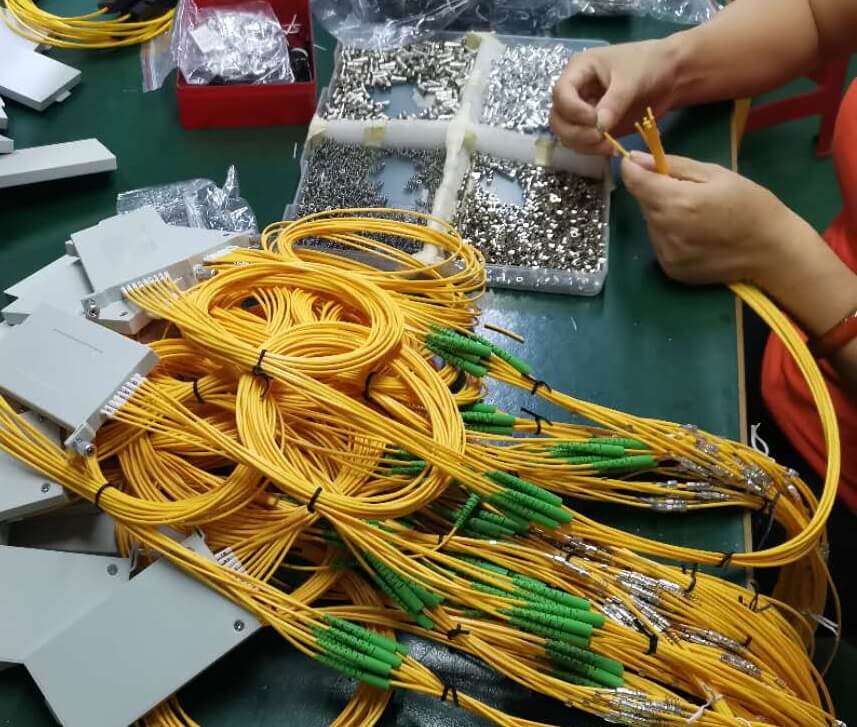
7. At the end
Different types of fiber optic splitters are used to meet the diverse requirements of OLT and ONT connection and splitting of optical signals on FTTH passive optical networks. We can determine the application occasion and choose the appropriate optical splitter according to the actual needs.
With the progress of the optical network transformation, the amount of optical splitter is increasing, and the quality of the optical splitter has an increasing impact on the optical network. Choosing a suitable, effective and economical optical splitter and manufacturer will allow us to reduce the investment and cost of maintenance and management. Bonelinks can provide various types of fiber optic splitters, including ABS PLC splitters, LGX splitters, rack-mounted PLC splitters, etc. Contact us if needed.


